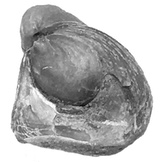Tools for field work
Note-taking forms
- Lithologic log: use for measuring and describing stratigraphic columns
- Common symbols for a lithologic log
- Faunal log: use for recording the changing abundance and distribution of fossils within a stratigraphic column
- Faunal tally: use for making counts of faunal abundances within stratigraphic units
- Locality: use for recording locality information, such as geographic location and stratigraphic interval
- Notes: use for taking general notes
An improved Jacob’s Staff
Anik Regan and I developed an improved Jacob’s Staff, using 3-D printing and an iOS app, which is significantly easier to use and has greatly reduced errors compared with traditional staffs. This error is particularly reduced in cases where the rocks are not exposed in the direction of dip, forcing a lateral sight. The staff is described in our 2020 article in the Journal of Sedimentary Research. Here, we include the files for creating the 3-D printed parts and a link to the iOS app called Jake for Stratigraphy. A couple of the parts have been redesigned slightly from the article to make them stronger.
If you are new to 3D printing, read my detailed guide to printing these parts. If you are already familiar with 3D printing, I recommend setting 4 wall loops and an infill density of 30% to make the parts stronger. Enable support during printing, which helps with parts that hollows and overhangs. Use ABS plastic rather than PLA, which warps at higher temperatures and in direct sunlight. For ABS, use an enclosed printer in a well-ventilated space. Set your nozzle temperature to 255°C, your bed temperature to 95°C, and your chamber temperature to 55°C. For the screws and nuts, add a 1 cm brim to help with bed adhesion.
Estimating true thickness of covered intervals where outcrop is oblique to dip
1) Measure the true strike of the strata (θstrike)
2) Measure the true dip of the strata (δ)
3) Measure the azimuth of the road (θroad)
4) Calculate the angle (β) between the road and the strike of the strata as
β = | θroad - θstrike |
5) Calculate the apparent dip (α) of the strata along the road as
α = arctan [sin(β) ⋅ tan(δ)]
6) Measure the apparent thickness (t) of the covered interval along the road using a Jacob staff set to the apparent dip of the strata along the road (α)
7) Calculate the true thickness (T) of the covered interval as
T = t ⋅ [cos(δ) / cos(α)]
Estimating the vertical distance between two horizontal beds with a rangefinder and clinometer
1) Using a laser rangefinder, measure the distance from you to the lower bed (a). Using a clinometer, measure the vertical angle to the bed (α).
2) Using the laser rangefinder and clinometer, make the same measurements for the upper bed (b and β).
3) Solve for the vertical distance between the beds (V), with
V = b sin(β) - a sin(α)
Code for drone-based section measurement
This R script will fit a plane to a set of points picked on a 3-d model obtained from drone-based photogrammetry, calculate the strike and dip of that plane, and rotate that plane so that it is horizontal. By removing the dip of the beds, the z-coordinate of each of the points represents stratigraphic position. Also, check out our poster from the 2016 GSA meeting.
Making acetate peels
Learn how to make an acetate peel along with getting the materials you will need. The method is explained for bryozoans, but it will work for any carbonate rock or fossil.

